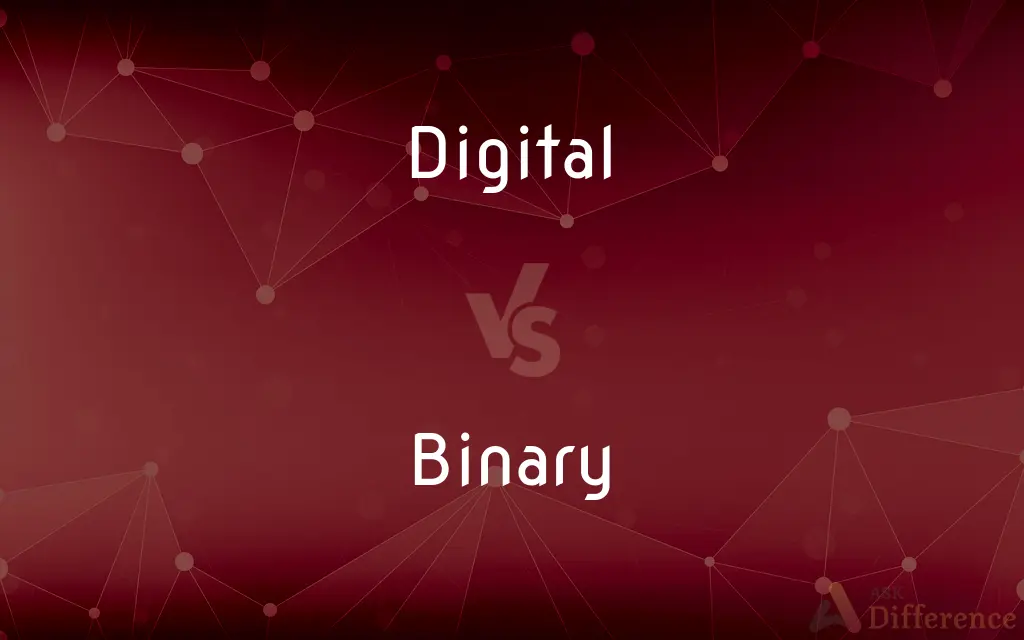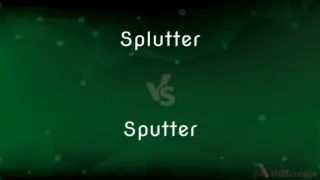Digital vs. Binary — What's the Difference?
By Fiza Rafique & Urooj Arif — Updated on March 15, 2024
Digital refers to technology that uses discrete signals for data processing and representation, while binary is a specific type of digital system that uses two distinct states (0 and 1) for this purpose.

Difference Between Digital and Binary
Table of Contents
ADVERTISEMENT
Key Differences
Digital technology encompasses a wide range of devices and systems that process information using discrete signals. These signals represent data as digits, which can vary in form but are distinct and separate from each other, allowing for the accurate reproduction and manipulation of information. On the other hand, binary is a subset of digital technology that specifically uses two states, often represented as 0 and 1, to encode and process data. This makes it the most basic form of digital representation.
While all binary systems are digital, not all digital systems are binary. Digital technology can use multiple discrete states beyond just two; however, binary is favored in computer systems and digital electronics due to its simplicity and reliability. Binary's straightforward nature allows for easier data processing and storage with less susceptibility to error, whereas digital systems using more than two states can encode more information per signal but may require more complex error-checking and correction methods.
In the context of data storage and transmission, digital technology refers to the method by which information is encoded into discrete units of data. Binary, as a form of digital encoding, specifically uses combinations of 0s and 1s to represent all possible data values. This binary encoding is foundational to computer operations, from basic arithmetic to complex processing tasks, because it aligns well with the on/off nature of electrical circuits.
Digital signals, in contrast to analog signals, offer advantages in terms of noise resistance and data integrity over long distances and after multiple transmissions. Binary, within the digital realm, exploits these advantages to the fullest by minimizing the complexity of signal interpretation and error correction, which is crucial for efficient computing and digital communication.
The application of digital technology spans a broad spectrum, from audio and video devices to telecommunications and beyond, utilizing various encoding schemes to suit different needs. Binary, however, remains the cornerstone of computing and digital electronics, underpinning everything from the simplest microcontrollers to the most complex supercomputers, illustrating its fundamental role in the digital age.
ADVERTISEMENT
Comparison Chart
Definition
Technology that processes data in discrete signals.
A digital system that uses two distinct states (0 and 1).
States Used
Can use multiple discrete states.
Uses exactly two states.
Application Scope
Broad, encompassing various forms of data encoding.
Specifically fundamental to computing and electronics.
Complexity
Varies; can be simple or complex depending on the system.
Generally simpler due to the use of only two states.
Error Correction
May require more complex methods in multi-state systems.
Simpler, as it deals with fewer possibilities for error.
Information Density
Can be higher in systems using more than two states.
Lower, as information is encoded with only two symbols.
Fundamental Role
In data processing and representation.
As the basis of digital computing and storage.
Example of Application
Digital audio and video, digital communication.
Computer processors, digital memory.
Compare with Definitions
Digital
Pertains to using discrete signals for data representation.
Digital clocks display time with distinct numeric digits.
Binary
Employs two symbols, 0 and 1, for data encoding.
Binary code is the basic language of computer systems.
Digital
Offers improved noise resistance over analog.
Digital TV signals maintain quality over long distances.
Binary
Simplifies error detection and correction.
Binary parity bits help detect errors in data transmission.
Digital
Facilitates precise data manipulation and storage.
Digital documents can be edited and copied without loss of quality.
Binary
Enables straightforward electrical circuit design.
Transistors in a computer's CPU use binary states to perform calculations.
Digital
Used in a variety of technologies beyond computing.
Digital cameras capture and store images as discrete pixels.
Binary
Fundamental to digital computing and storage.
Binary data is stored in a computer's hard drive as magnetic or electronic states.
Digital
Can encode data in multiple levels or states.
A digital signal processor can handle complex waveforms for audio.
Binary
Basis for boolean logic in computing.
Binary logic gates form the building blocks of digital circuits.
Digital
Relating to or resembling a digit, especially a finger.
Binary
Relating to, composed of, or involving two things.
Digital
Operated or done with the fingers
A digital switch.
Binary
Relating to, using, or denoting a system of numerical notation that has 2 rather than 10 as a base.
Digital
Having digits.
Binary
The binary system of notation
The device is counting in binary
Digital
Expressed in discrete numerical form, especially for use by a computer or other electronic device
Digital information.
Binary
Something having two parts.
Digital
Relating to or being a device that can generate, record, process, receive, transmit, or display information that is represented in discrete numerical form.
Binary
Characterized by or consisting of two parts or components; twofold.
Digital
Relating to or being a service that provides information expressed in discrete numerical form
We subscribe to digital cable.
Binary
Of or relating to a system of numeration having 2 as its base.
Digital
Relating to or being a profession or activity that is performed using digital devices
A digital librarian.
Digital photography.
Binary
Of or relating to a system of encoding data using only 0's and 1's.
Digital
Using or giving a reading in digits
A digital clock.
Binary
(Chemistry) Consisting of or containing only two kinds of atoms.
Digital
Characterized by widespread use of computers
Living in the digital age.
Binary
(Music) Having two sections or subjects.
Digital
A key played with the finger, as on a piano.
Binary
A number system having 2 as its base.
Digital
Having to do with digits (fingers or toes); performed with a finger.
Binary
A file that contains the executable version of a computer program.
Digital
Property of representing values as discrete, often binary, numbers rather than a continuous spectrum.
Digital computer
Digital clock
Binary
A binary star.
Digital
Of or relating to computers or the Information Age.
Digital payment systems are replacing cash transactions.
Binary
Being in one of two mutually exclusive states.
Binary states are often represented as 1 and 0 in computer science.
Digital
(finance) A digital option.
Binary
(logic) Concerning logic whose subject matter concerns binary states.
Digital
(uncountable) Digital equipment or technology.
He moved to digital for the first time, using a Sony camera.
Binary
Concerning numbers and calculations using the binary number system.
Digital
(music) Any of the keys of a piano or similar instrument.
Binary
Having two equally important parts; related to something with two parts.
Binary star
Two ingredients are combined in a binary poison.
A binary statistical distribution has only two categories.
Digital
A finger.
Binary
Of an operation, function, procedure, or logic gate, taking exactly two operands, arguments, parameters, or inputs; having domain of dimension 2.
Division of reals is a binary operation.
Digital
Of or pertaining to the fingers; done with the fingers; as, digital compression; digital examination.
Binary
(computing) Of data, consisting coded values (e.g. machine code) not interpretable as plain or ASCII text (e.g. source code).
Plain text
He downloaded the binary distribution for Linux, then burned it to DVD.
Digital
Of or pertaining to digits{3}; expressed in digits{3}, or using digits{3}; as, a digital display; a digital clock.
Binary
(comparable) Focusing on two mutually exclusive conditions.
He has a very binary understanding of gender.
Digital
Performing internal logical and arithmetic operations by means of digits, usually represented as binary numbers. Contrasted to analog, wherein variables are represented as coninuous physical quantities such as voltages or the position of a pointer on a continuous scale; as, a digital computer.
Binary
A state in which only two values are possible, in which something must have one value or the other.
Digital
Of a circuit or device that represents magnitudes in digits;
Digital computer
Binary
The bijective base-2 numeral system, which uses only the digits 0 and 1.
Digital
Displaying numbers rather than scale positions;
Digital clock
Digital readout
Binary
(computing) binary file; a file consisting of data other than human-readable text.
Digital
Relating to or performed with the fingers;
Digital examination
Binary
(astronomy) binary star.
Binary
Compounded or consisting of two things or parts; characterized by two (things).
Binary
That which is constituted of two figures, things, or parts; two; duality.
Binary
A system of two stars that revolve around each other under their mutual gravitation
Binary
Of or pertaining to a number system have 2 as its base;
A binary digit
Binary
Consisting of two (units or components or elements or terms) or based on two;
A binary star is a system in which two stars revolve around each other
A binary compound
The binary number system has two as its base
Common Curiosities
Why is binary preferred in computing?
Binary is preferred for its simplicity and reliability, aligning well with the on/off nature of electrical circuits in computing.
Can digital systems use more than two states?
Yes, digital systems can use multiple states, though binary is the most fundamental due to its simplicity.
What is binary?
Binary is a system within digital technology that uses two distinct states, 0 and 1, to encode data.
How do digital and binary differ?
Digital is a broad category of technology that can use various discrete states, while binary specifically uses two.
What is digital technology?
Digital technology refers to systems that use discrete signals for processing and representing data.
What advantages do digital signals have over analog?
Digital signals offer better noise resistance and maintain data integrity over long distances and after multiple transmissions.
How does binary affect computing?
Binary underpins all levels of computing and digital storage, from basic operations to complex processing tasks.
What role does binary play in digital communication?
Binary coding is crucial for efficient data transmission, allowing for clear differentiation between signal states.
Can digital technologies work without binary systems?
While binary is foundational, digital technologies can and do employ other encoding schemes for specific applications.
How does binary simplify error correction?
With only two states, binary systems have simpler error detection and correction mechanisms compared to multi-state digital systems.
Is all digital technology binary?
No, not all digital technology is binary; binary is a subset of digital technology.
What makes digital signals more reliable than analog?
Digital signals are less susceptible to degradation over distance and interference, making them more reliable for precise data representation.
Why are binary systems simpler than other digital systems?
Binary's use of only two states simplifies the design and operation of digital circuits, enhancing reliability and efficiency.
How do digital and binary technologies impact everyday life?
They are integral to the operation of computers, smartphones, digital media, and much of modern technology, shaping communication, entertainment, and work.
How do binary systems work in digital electronics?
Binary systems in electronics use two states to represent and manipulate data, making use of transistors that can be either on or off.
Share Your Discovery

Previous Comparison
Splutter vs. Sputter
Next Comparison
Spot vs. BlemishAuthor Spotlight
Written by
Fiza RafiqueFiza Rafique is a skilled content writer at AskDifference.com, where she meticulously refines and enhances written pieces. Drawing from her vast editorial expertise, Fiza ensures clarity, accuracy, and precision in every article. Passionate about language, she continually seeks to elevate the quality of content for readers worldwide.
Co-written by
Urooj ArifUrooj is a skilled content writer at Ask Difference, known for her exceptional ability to simplify complex topics into engaging and informative content. With a passion for research and a flair for clear, concise writing, she consistently delivers articles that resonate with our diverse audience.













































